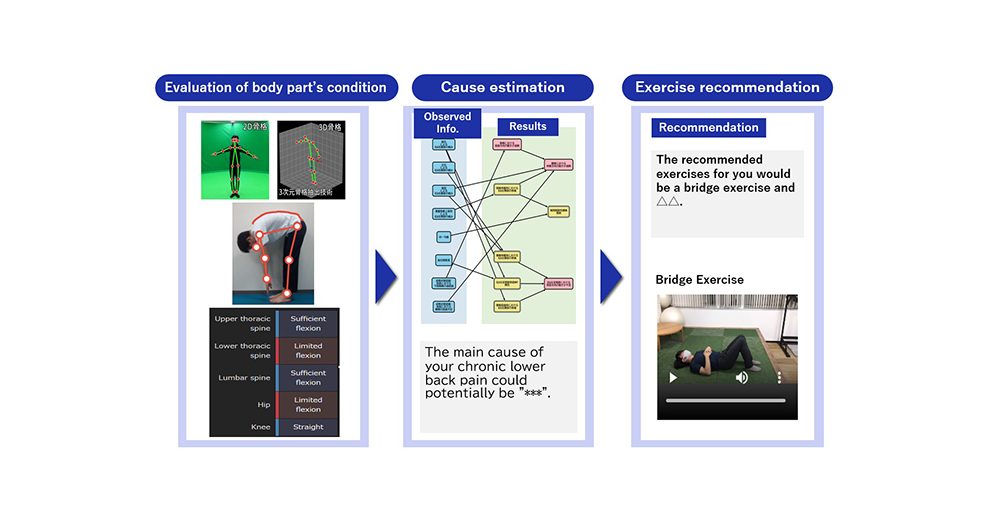AI can help self-care for individuals suffering from chronic non-specific lower back pain

NEC Corporation and Tokyo Medical and Dental University (TMDU) have collaborated to create a groundbreaking technology aimed at revolutionizing self-care for individuals suffering from chronic non-specific lower back pain (CLBP). Utilizing the power of AI, this technology leverages smart devices to analyze images and interviews — offering users a convenient way to monitor their lower back condition, pinpoint potential causes, and receive personalized exercise recommendations, accessible anytime and anywhere.
How does it work?
The foundation of this technology rests on NEC's cutting-edge AI capabilities, including advanced 2D/3D human pose estimation and abductive reasoning, enriched with TMDU's extensive medical knowledge. Through images captured by a user's smartphone, it precisely estimates the human skeletal structure, assesses the condition of different body parts, identifies the likely causes of CLBP, and proposes a customized exercise regimen tailored to the user's specific symptoms.
Key features of this innovative technology include:
- Accurate Human Pose Estimation: Despite the challenges posed by varying shooting angles, NEC's sophisticated 2D/3D pose estimation technology ensures precise skeletal structure estimation, overcoming the inaccuracies typical in conventional methods.
- Detailed Condition Evaluation: By evaluating the shape of the back and its relation to other body parts, this technology offers expert-level precision in assessing each body part's condition, a significant step beyond traditional approaches.
- Quick Cause Identification: Leveraging abductive reasoning with a Satisfiability Assessment Problem (SAT) solver, the system can rapidly pinpoint the primary causes of CLBP, utilizing both image and interview data to do so within an average of just 10 seconds.
Following these analyses, the technology presents an exercise program on the user's device, featuring video tutorials that can be followed from the comfort of home, designed to alleviate CLBP based on the identified causes.
Why does it matter?
This technological advancement is a significant milestone in the field of medical self-care, particularly for those battling chronic lower back pain — a condition that affects a vast number of individuals globally. By providing easy access to personalized, expert-backed advice and exercise programs, it empowers individuals to take charge of their health, potentially reducing the need for frequent medical consultations and offering a convenient solution for ongoing self-management of CLBP.
This AI-driven approach not only enhances the accuracy of diagnosis and treatment plans but also makes specialized care more accessible to those in need, regardless of their location or schedule.
What's next?
Looking ahead, NEC and TMDU are set to undertake trials to validate the effectiveness of this technology at an NEC care center in Tokyo, among other venues, throughout the fiscal year 2024.
Beyond its current application for CLBP, there are plans to broaden the scope of this technology to address other musculoskeletal disorders, including neck and shoulder issues. This expansion aims to leverage the potential of AI in transforming self-care practices for a wider range of conditions, potentially revolutionizing how individuals manage and mitigate chronic pain and improving the overall quality of life for many.
The context
According to a study conducted by Japan's Ministry of Health, Labour and Welfare in 2022, lower back pain is the leading subjective symptom of illness or injury in Japan for both men and women. Lower back pain often becomes chronic and is a major health problem that significantly impairs life functions, and at the same time, it may also cause problems such as increased social security costs for medical and nursing care benefits.
However, in order to improve the symptoms of CLBP, it is necessary to visit the clinic several times a month continuously, and many people are unable to receive adequate services due to distance and time constraints.
As the population continues to age, there are high expectations for technology to encourage appropriate exercises for improving symptoms and preventing the worsening or recurrence of CLBP. And that's what this cooperation between NEC and TMDU is all about. Pretty cool.
💡Did you know?
You can take your DHArab experience to the next level with our Premium Membership.👉 Click here to learn more
🛠️Featured tool
 Easy-Peasy
Easy-Peasy
An all-in-one AI tool offering the ability to build no-code AI Bots, create articles & social media posts, convert text into natural speech in 40+ languages, create and edit images, generate videos, and more.
👉 Click here to learn more


